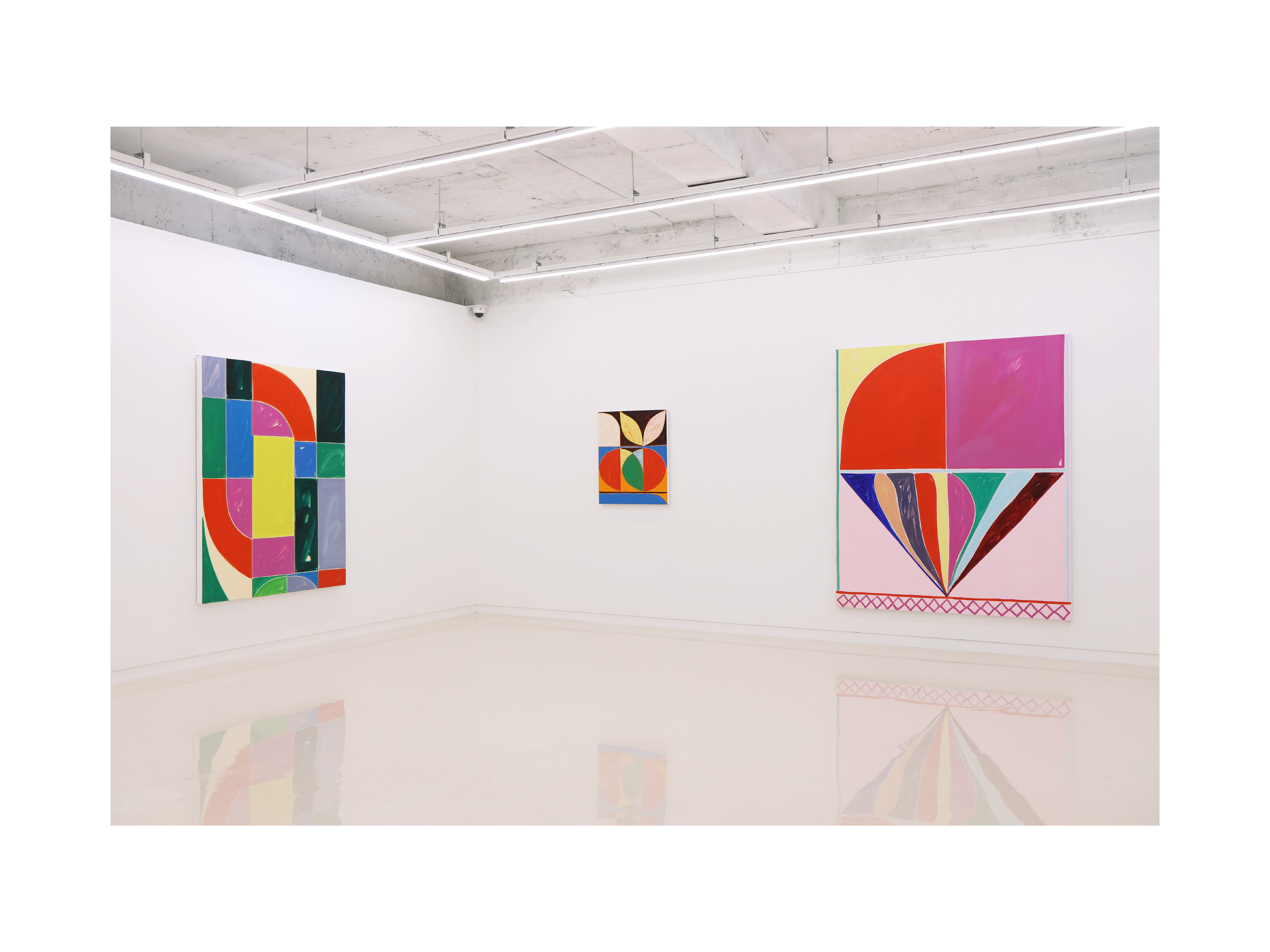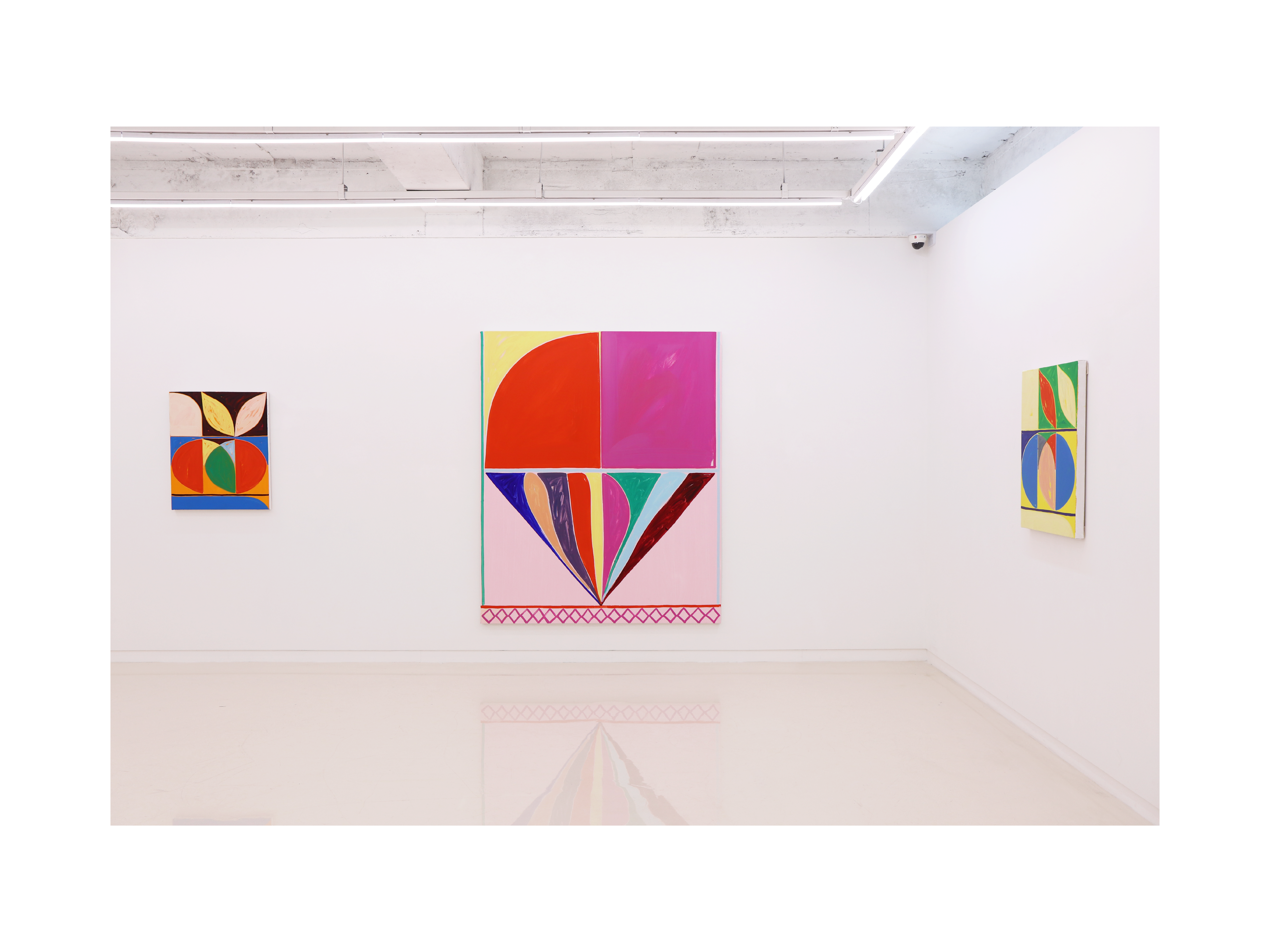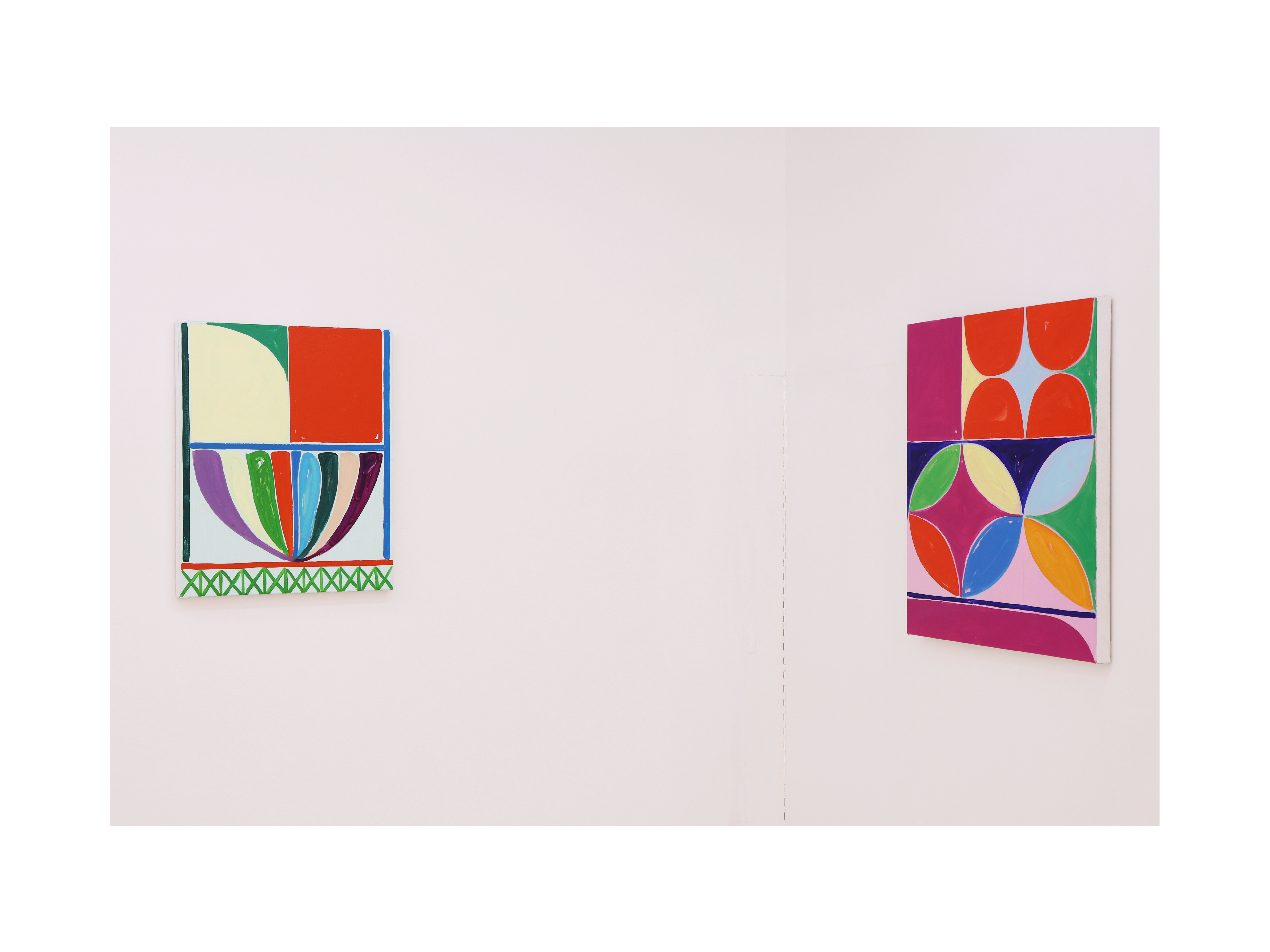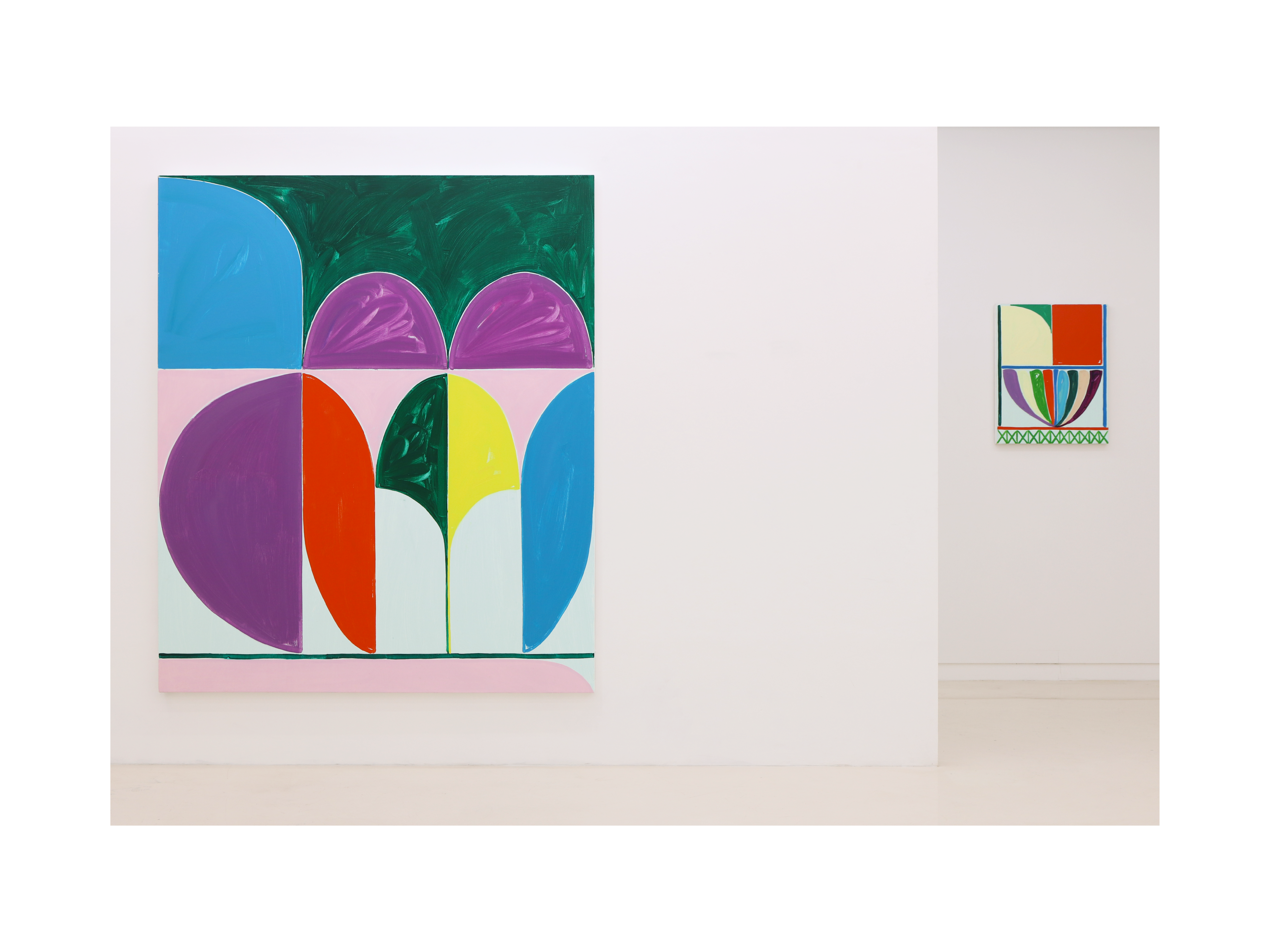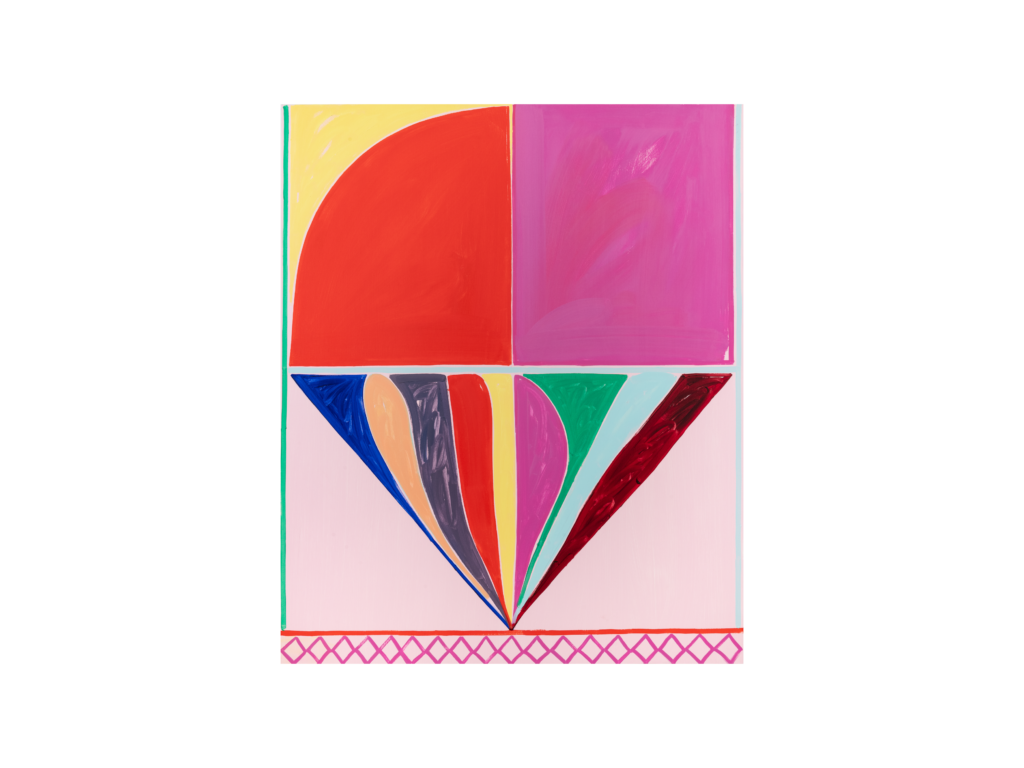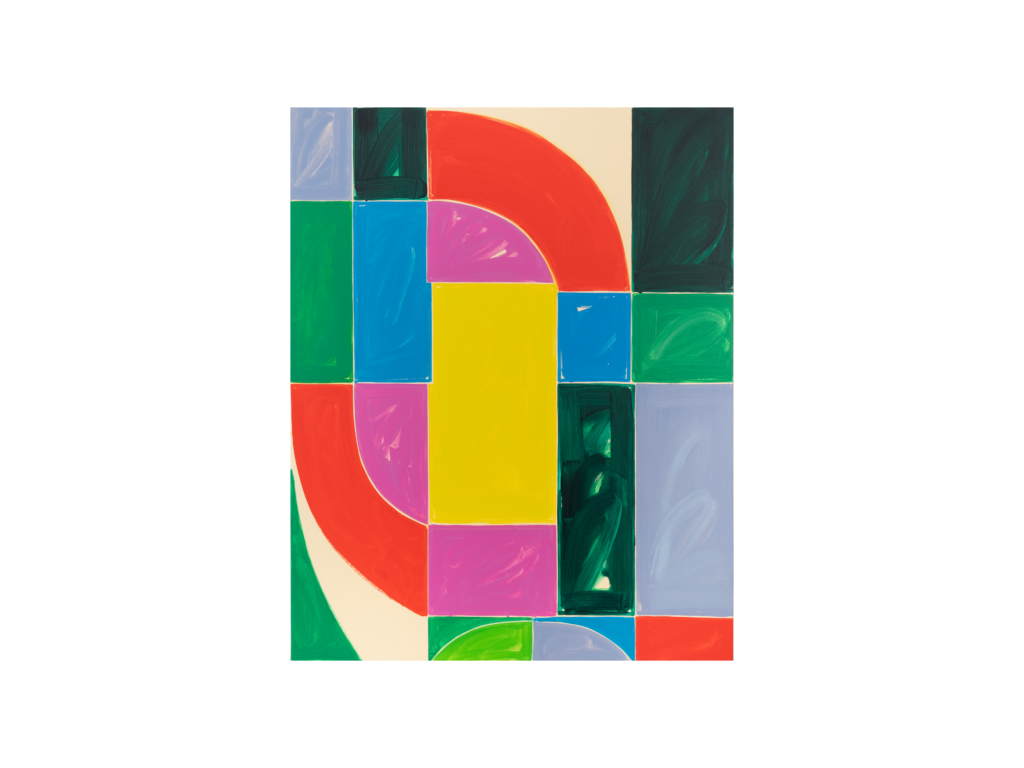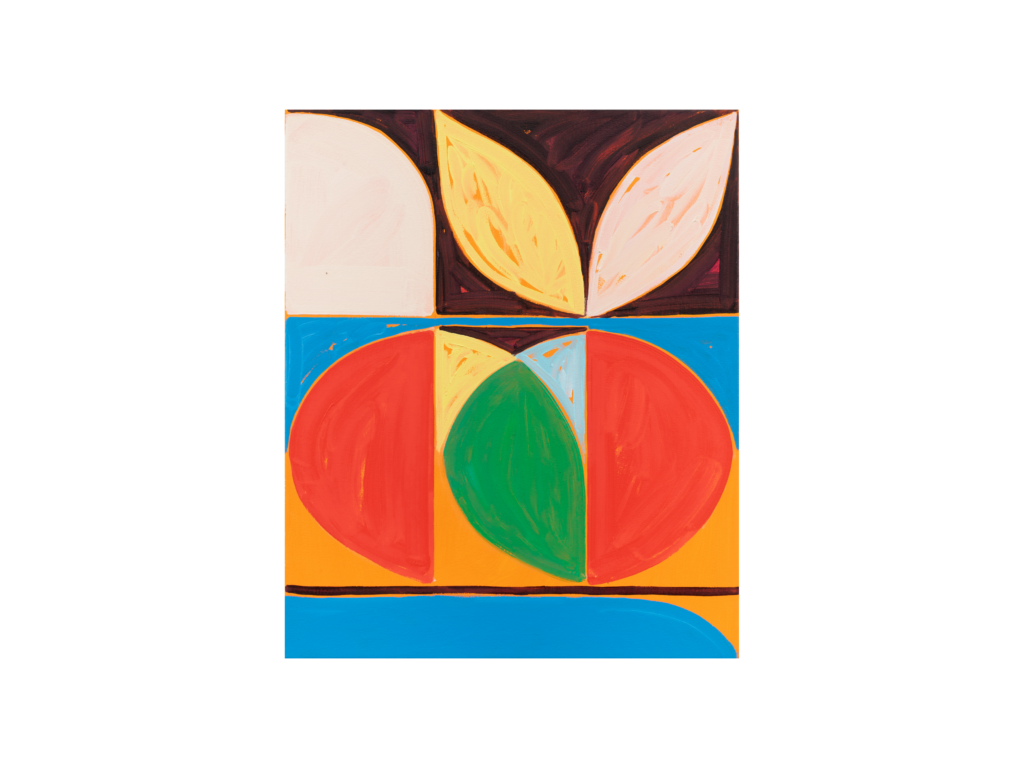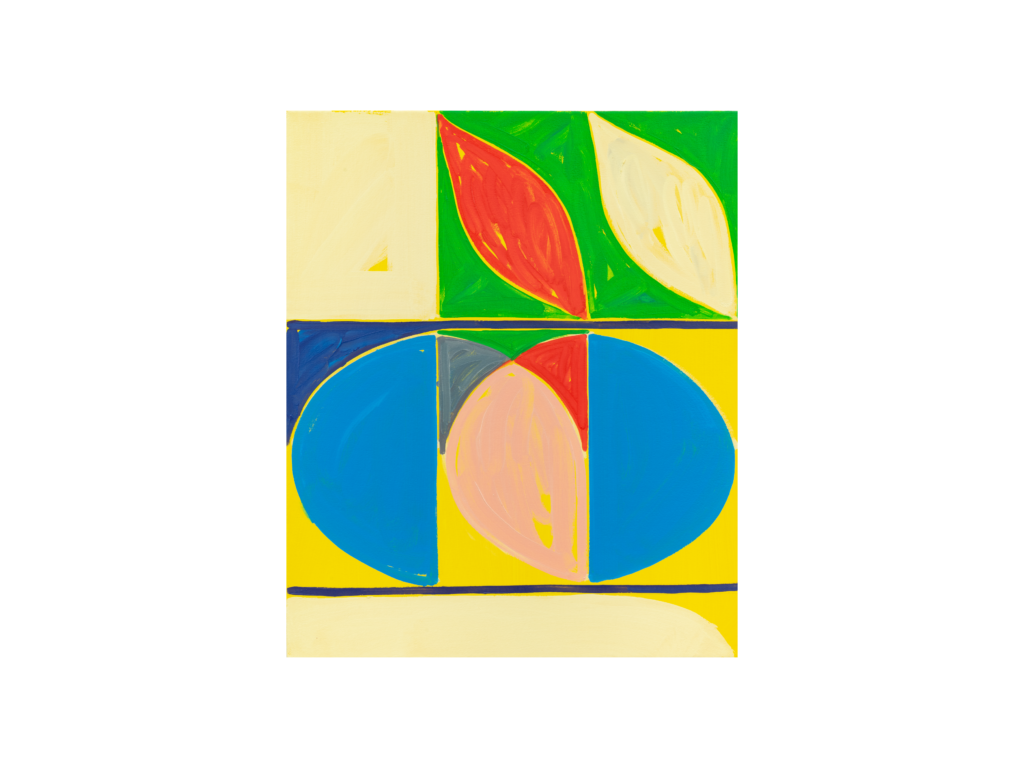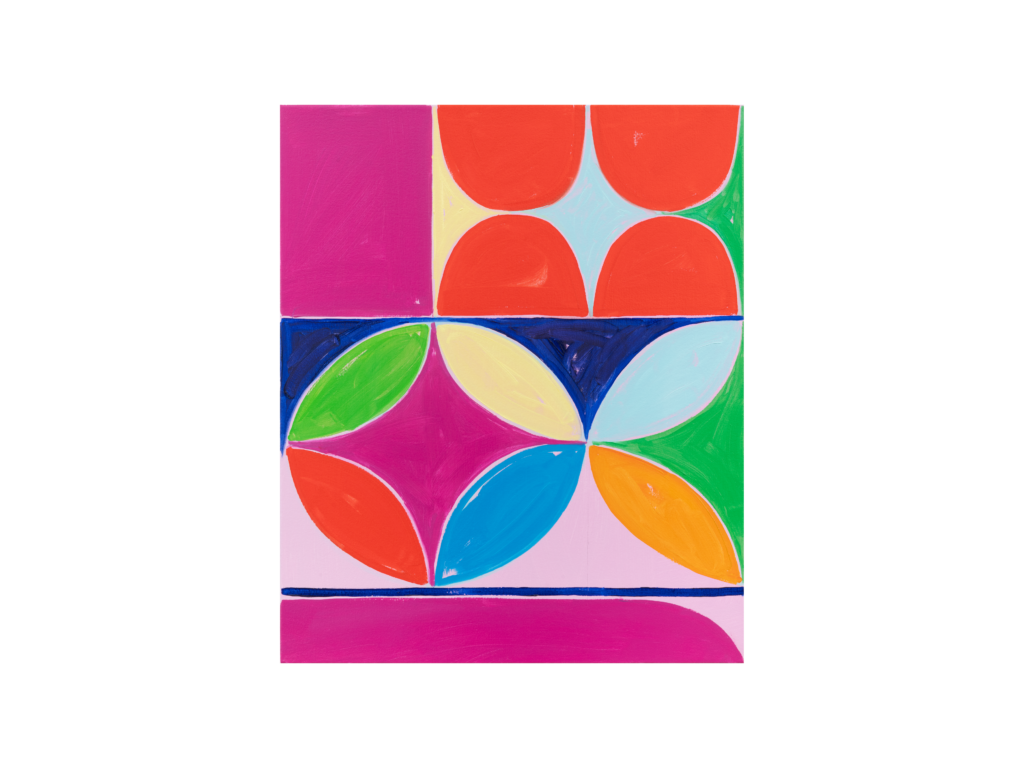Glass Arcadia
A Solo Exhibition by Jason Stopa
May 4 - June 20, 2024
Wed - Sat, 11am - 6pm
<GLASS ARCADIA> is the first solo exhibition of New York-based artist Jason Stopa with Thomas Park. Stopa’s paintings, composed of geometric shapes and architectural elements, are distinctive with bright, optimistic hues. He is interested in creating a sense of space and place which is idealistic. His recent works, gesturally painted with a thin wash of oil paint, are "adorned" with elements like lattice, hinting at an actual space.
Stopa wants the viewers "to think of the work as a mode of being or acting in a space, which feels to me like a social idea about abstraction. The marks and forms in my paintings are actors acting in the space. I'm looking at certain architectural moments to draw forms from. These actors come together and have relationships that bend, conform, and act out the drama of the work. They play out tensions, sometimes complementary, vying for position, vying for space, but maybe through togetherness.”
—
When I first saw one of his recent series, Reflection Pool VI (2024), I thought of Matisse's window paintings. Even though Stopa's compositions are structured by a grid, he retains the fluidity and sensuality reminiscent of Matisse; the brightly colored planes with the lattice pattern on the bottom do remind a window. While bearing in mind Matisse's treatment of the loaded meaning of a "window," Stopa plays with the idea of what art can do in this radically changing time as Constructivists did in revolutionary Russia. Stopa's work does not bear any resemblance to the Russian's pursuit of a revolutionized form of art, but on another level, Stopa's construct of paintings seems to revolve around certain Constructivist concepts, such as faktura—the particular material properties of an object— and tektonika, its spatial presence. Each colored shape in his painting with historical reference and a specific way of handling the paint seems to act, in a way, as faktura; their positions and movements in space, tektonika.
In fact, Stopa approaches abstraction as a "historical project." He draws inspiration from the surface of ancient Greek pottery, for example, or takes a form rooted in idealism or utopia and then alters it. His paintings reflect his thoughts on specific sites of utopian ideas, like No Stop City or Acrosanti, AZ, inviting the audience to delve into his vision of painting.
"I'm interested in how an abstract painting can reconstitute something from the past—acknowledging its context and history—so that it can argue for its relevancy today… My color isn't arbitrary; it's a color that's rooted in early Henri Matisse, Bob Thompson, Stanley Whitney, and Mary Heilmann. It's a graphic, optimistic color loaded with content about mythologies, Arcadia, and joy. To use that palette is to reference that content.”
Stopa's exploration of utopianism feels refreshing and timely in a world where everyone is heated with or devastated by 'wars'—both ideological and actual. His work demands that we question the dystopian conditions we create for ourselves and our tendency to be destructive. Do we even envision a better world at this point, if not an ideal?
From 1929 to 31, Vladimir Tatlin, a founder of Russian Constructivism, played Daedalus and built a human glider called Letatlin. It is an object hanging from the ceiling, looking like a bird's fossil skeleton. He built it to be used, to unite communities, and to give people a liberating, even spiritual experience. He said, "It was for people; it was a socialist artifact, both art and utility." Can a painting be as "useful" as Letatlin? Stopa seems to agree with the idea.
"My paintings use architecture to reference utopias of all stripes: ecological, religious, and personal. I see my motifs as structures that rest on lattices, sit on fences and recline on slopes...I see these sites as pointing toward possible futures. In a time of ecological crisis and political polarization, envisioning a new, possible world seems more important than ever."
Stopa's recent works came from his experience in the summer of 2023 in Cassis, France, where he was in an artist's residency. He traveled and saw Matisse's work in The Rosary Chapel in Vence. The floral stained glass windows in the chapel in bright yellow, green, and blue, had a profound impact on him. Stopa's brightly colored planes may channel Matisse's pursuit of balance, purity, and serenity. Even if it is fragile, we might be able to glimpse the Arcadia the old master dreamed of. And we could ask ourselves this question: Can art convince us to envision a better world?
Mimi Park
<GLASS ARCADIA는 뉴욕에서 활동하는 작가 제이슨 스토파의 첫 개인전이다. 기하학적 도형과 건축적 요소로 구성된 스토파의 그림은 밝고 낙관적인 색채가 특징이다. 그는 이상주의적인 공간과 장소에 관련된 감각을 일으키는 작업에 관심이 있다. 유화를 묽게 칠한 그의 최근 작품은 격자 무늬 같은 요소로 '장식'되어 실제 존재하는 공간을 암시한다.
스토파는 이렇게 말한다. “나는 관객들이 작품들을 한 공간 안에서 존재하거나 작용하는 방식이라고 생각하기를 바란다. 이는 추상을 사회적으로 접근하는 관점이라고 본다. 내 그림 속의 흔적이나 형태는 공간에서 연기하는 배우들이다. 나는 어떤 특정적인 건축적 순간에서 형태를 얻는데, 이 “배우"들은 함께 모여 서로를 굽히고, 순응하고, 드라마를 연기하는 관계를 맺는다. 때로는 서로 보완하고 때로는 위치와 공간을 차지하기 위해 경쟁하며 긴장감을 조성하지만, 어쩌면 함께 하기 때문에 이 모든 것이 가능하다.”
—
스토파의 최근 시리즈 중 하나인 Reflection Pool VI(2024)를 처음 봤을 때 나는 마티스의 창문 그림들이 떠올랐다. 스토파의 작품은 격자 위에 구성되었지만 마티스를 연상시키는 유연하고 감각적인 터치를 유지하고 있다. 특히 밝은 색상의 면 조각들과 하단의 격자 무늬가 실제로 마티스가 그렸던 창문들을 연상시킨다. 스토파는 마티스가 다룬, ‘창문'이라는 소재에 담긴 미술사적 의미를 염두에 둔 동시에 스토파는 혁명기 러시아에서 구성주의자들이 그랬던 것처럼 급변하는 시대에 예술이 무엇을 할 수 있는지를 생각하고 있는 듯하다. 그의 작품은 러시아의 혁명적 예술과 표면적으로는 닮은 점이 없어 보이지만, 다른 차원에서 보면 구성주의의 어떤 개념들을 중심으로 전개되는 듯 보인다. 작품의 물질적 특성을 뜻하는 용어, “팍투라faktura”와 그 오브제의 공간적인 존재 양상을 말하는 “텍토니카tektonika”가 그것이다. 스토파의 그림에서 역사적인 레퍼런스를 담아 특정한 방식으로 그려진 각각의 색면은 어떤 의미에서 “팍투라”로, 그들의 공간 속에서의 위치와 움직임은 “텍토니카”로 작용하는 듯하다.
실제로 스토파는 추상화를 "역사적 프로젝트"로 접근한다. 예를 들어 그는 고대 그리스 도자기의 표면에서 영감을 얻거나 이상주의나 이상향을 담은 어떤 형태를 취한 다음 이를 변형하는 것이다. 그의 그림은 노 스톱 시티No Stop City나 애리조나주 아크로산티Acrosanti와 같은 유토피아적 장소를 레퍼런스로 반영한다.
“나는 추상 회화가 과거의 맥락과 역사를 인정하면서 어떻게 이들을 재구성하여 오늘날 의미를 지니는지 살펴보는 것에 관심이 있다... 내가 사용하는 색깔은 자의적인 것이 아니라 초기 앙리 마티스, 밥 톰슨, 스탠리 휘트니, 메리 하일만이 사용한 색들에 그 근거를 둔다. 신화, 아르카디아, 기쁨에 대한 레퍼런스가 담긴 생생하고 낙관적인 색상이다. 이 색상들을 사용하는 것은 그 내용을 레퍼런스로 택하는 행위라 할 수 있다."
스토파가 “유토피아”에 대해 탐구한다는 사실은 이 시대 모두가 ‘전쟁’—이념에 관한, 그리고 실제 일어나고 있는—에 몰두하거나 또는 그로 인해 피폐해진 상황에서 신선한 동시에 시의적절하게 느껴진다. 그의 작품은 우리 스스로 만들어낸 디스토피아와 우리의 파괴적인 성향에 대해 반추해볼 것을 요구하는 듯하다. 이상향까지 가지 않더라도, 우리는 과연 더 나은 세상을 원하고 있다고 할 수 있을까?
러시아 구성주의의 창시자인 블라디미르 타틀린은 다이달로스의 역할을 하며, 1929년에서 31년까지 레타틀린Letatlin이라는 인간 글라이더를 만들었다. 레타틀린Letatlin은 천장에 매달아 설치한 새의 화석 같은 작품이다. 그는 공동체를 단결시키고 사람들에게 해방감과 영적인 경험을 선사하기 위해 이 작품을 제작했다며, ”사람들을 위한, 예술과 실용성을 모두 갖춘 사회주의 유물이었다”고 말했다. 날개도 없는 한 점의 그림이 이 정도로 ‘실용적’일 수 있을까? 스토파는 이 질문에 긍정적인 답을 갖고 있는 듯하다.
“내 작업은 생태적, 종교적, 개인적 유토피아 등 여러 측면의 유토피아에 대한 레퍼런스로 건축물을 사용한다. 격자 구조 위 또는, 펜스 위에 놓여있는, 또는 경사면에 기대어 있는 구조물을 모티브로 삼는다... 나는 이러한 건축이 미래의 가능성을 가리키고 있다고 생각한다. 생태적 위기와 정치적 양극화의 시대에 새롭고 가능한 세상을 상상하는 것이 그 어느 때보다 중요하다고 나는 생각한다.”
이 전시에서 소개되는 스토파의 최근 작들은 2023년 여름, 프랑스 카시에 있는 아티스트 레지던시에 머물렀던 경험에서 영감을 얻은 것이다. 그곳에 머무를 때 그는 방스에 위치한 로사리오 성당에 가서 마티스의 작품을 보게 되었고, 노랑, 초록, 파랑색의 스테인드글라스는 그에게 깊은 인상을 남겼다. 마티스는 균형감, 순수함, 평온함을 꿈꾼 예술가였고, 우리는 스토파의 밝은 평면에서 이를 느낄 수 있다. 우리는 비록 연약할지라도 20세기 거장이 꿈꿨던 아르카디아를 엿볼 수 있을지도 모른다. 우리는 심지어 이런 질문까지 할 수 있을 듯하다. 예술이 우리가 더 나은 세상을 꿈꾸도록 설득할 수 있을 것인가?
박상미
